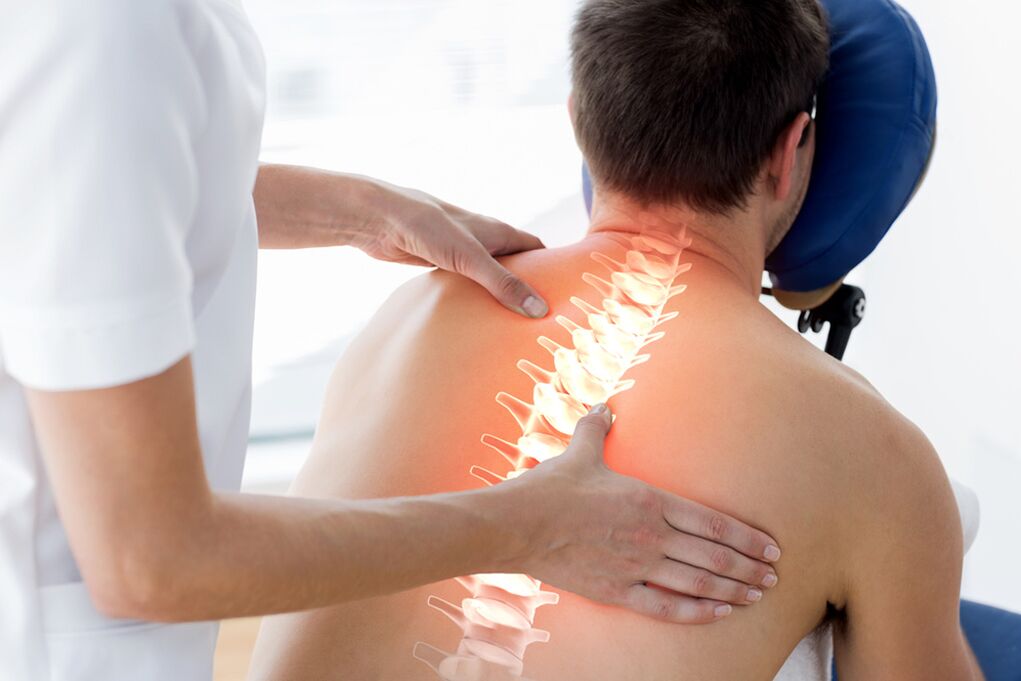Thoracic osteochondrosis occurs with damage to the thoracic discs. Symptoms of the disease are similar to those of cervical and lumbar spine lesions. Osteochondrosis of the thoracic spine is difficult and often undiagnosed.

Symptoms of thoracic osteochondrosis in women
This disorder is rare in women because there is less pressure on the thoracic spine compared to the rest of the spine. Thoracic osteochondrosis of the spine is difficult to diagnose because the disease usually manifests in the advanced stages of the disease.
The main symptom of thoracic osteochondrosis in women is soreness. Pain is usually located in the back, breastbone, and can also radiate to the upper extremities. Additionally, women may suffer from stomach pains. First, the localization of pain depends on the stage of the disease course.
Typically, with thoracic osteochondrosis, women experience constant, non-sharp pain. Signs of thoracic osteochondrosis also depend on the sensitivity and individual characteristics of a woman's body.
In the beautiful half of humanity, the symptoms of the disease are more pronounced: women's bodies are more sensitive, and all parts of the spine are thinner than men's. The process of degeneration and malnutrition in women is more prone to negative reactions.
With the failure of the spinal thoracic segment, fairness has the following symptoms:
- soreness when you lift your arm or bend over;
- breast pain;
- Sternal discomfort, aggravated by various loads or prolonged sitting;
- pain with deep breathing;
- severe pain between the shoulder blades in the spinal area;
- pressure in the chest;
- Vascular dystonia.
The symptoms described above are caused by processes that occur in the spine itself. In the case of the formation of an intervertebral hernia, symptoms appear due to the development of vascular and neuropathology.
Common presentations in women with thoracic osteochondrosis:
- Frequent "goose bumps" and numbness in shoulders and arms;
- Burning, cold, or itching in the lower extremities;
- pain in the heart area;
- increased brittleness of the nails, peeling of the skin;
- Pathology of the function of the digestive organs: nausea, constipation or diarrhea, abdominal distension.
Because the symptoms of thoracic osteochondrosis resemble pneumonia, angina, or heart disease, a differential diagnosis is necessary. All of the above manifestations indicate the development of thoracic vertebral osteochondrosis. However, you should not self-medicate. Only a doctor can establish an accurate diagnosis and prescribe an effective treatment plan.
Symptoms of thoracic osteochondrosis in men
Osteochondrosis of the thoracic spine is usually diagnosed in men when the spine is subjected to high loads (for example, it is often found in construction workers, loaders, etc. ). In this case, the clinical manifestations of osteochondrosis appeared gradually, with slow damage to the joints between the ribs and vertebrae. The earlier the disease is diagnosed, the more effective the treatment will be.
In the early stages, thoracic vertebral osteochondrosis does not have any special manifestations, and the patient lives without knowing the progression of the disease. Any discomfort is usually attributed to fatigue or uncomfortable posture after long hours of work.
Signs of early thoracic osteochondrosis in men:
- Due to the compaction of the soft tissues, the elasticity of the joint area is reduced, a constriction occurs between the shoulder blades, in the sternum, clavicle area;
- Difficulty lifting the arm and placing it behind the back due to the compromised flexibility of the shoulder straps;
- discomfort in the affected area of the chest;
- Fatigue in the back after prolonged exercise or standing still;
- Soreness occurs when you take a deep breath.
As the disease progresses further, the following symptoms are observed:
- The pain becomes more intense and persistent. Soreness is observed even at rest due to the constant pressure on the nerve endings;
- numbness, tingling in areas where sensitivity is impaired;
- Periodic reflex spasms of the abdominal muscles, accompanied by discomfort;
- Fake episodes of angina, renal colic, or hepatic colic that can afflict a person;
- Potential damage to pelvic organs, as well as decreased efficacy;
- The development of irritable bowel syndrome due to the formation of osteochondrosis of the thoracic spine - a pathology of the function of the digestive organs.
Symptoms of thoracic osteochondrosis coma
The sensation of sternal coma occurs in many patients, but not everyone takes it seriously because the phenomenon is characterized by a short duration and a rapid disappearance.
What caused this phenomenon? Often, a feeling of sternal coma occurs due to a disorder of the nervous system. However, sometimes the cause of these sensations is thoracic osteochondrosis, as there are numerous plexuses in the chest area.
Due to this pathology, intercostal neuralgia usually occurs. In this case, the patient experiences pressure in the back of the chest and pain that worsens when the body moves or lifts weights. In this case, the pain resembles a needle stick and intensifies with breathing.
The most common causes of thoracic osteochondrosis are improper lifestyle, sedentary work and impaired metabolism. Conservative medication, manual therapy, and laser therapy will come to the rescue. Encourage patients to participate in sports or fitness.























